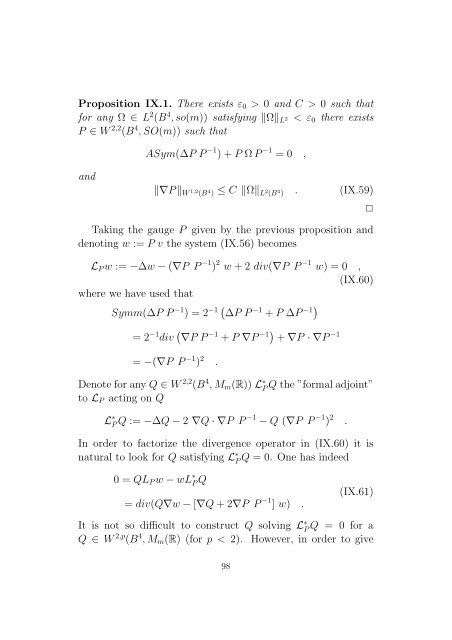Conformally Invariant Variational Problems. - SAM
Conformally Invariant Variational Problems. - SAM
Conformally Invariant Variational Problems. - SAM
You also want an ePaper? Increase the reach of your titles
YUMPU automatically turns print PDFs into web optimized ePapers that Google loves.
Proposition IX.1. There exists ε 0 > 0 and C > 0 such that<br />
for any Ω ∈ L 2 (B 4 ,so(m)) satisfying ‖Ω‖ L<br />
2 < ε 0 there exists<br />
P ∈ W 2,2 (B 4 ,SO(m)) such that<br />
ASym(∆P P −1 )+P ΩP −1 = 0 ,<br />
and<br />
‖∇P‖ W<br />
1,2<br />
(B 4 ) ≤ C ‖Ω‖ L2 (B 4 ) .<br />
(IX.59)<br />
✷<br />
Taking the gauge P given by the previous proposition and<br />
denoting w := P v the system (IX.56) becomes<br />
L P w := −∆w−(∇P P −1 ) 2 w+2 div(∇P P −1 w) = 0 ,<br />
(IX.60)<br />
where we have used that<br />
Symm(∆P P −1 ) = 2 −1( ∆P P −1 +P ∆P −1)<br />
= 2 −1 div ( ∇P P −1 +P ∇P −1) +∇P ·∇P −1<br />
= −(∇P P −1 ) 2 .<br />
Denote forany Q ∈ W 2,2 (B 4 ,M m (R)) L ∗ PQ the ”formaladjoint”<br />
to L P acting on Q<br />
L ∗ P Q := −∆Q−2 ∇Q·∇P P−1 −Q (∇P P −1 ) 2 .<br />
In order to factorize the divergence operator in (IX.60) it is<br />
natural to look for Q satisfying L ∗ PQ = 0. One has indeed<br />
0 = QL P w−wL ∗ PQ<br />
= div(Q∇w−[∇Q+2∇P P −1 ] w) .<br />
(IX.61)<br />
It is not so difficult to construct Q solving L ∗ P Q = 0 for a<br />
Q ∈ W 2,p (B 4 ,M m (R) (for p < 2). However, in order to give<br />
98
















